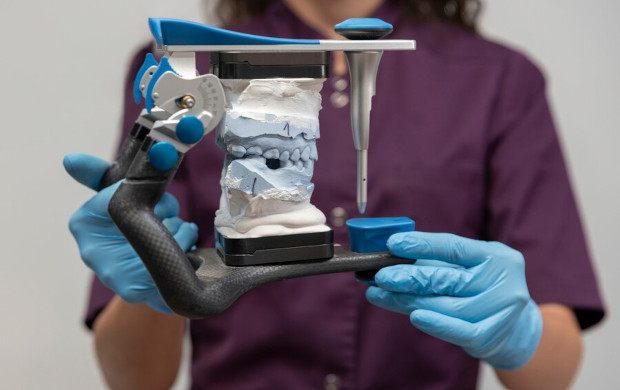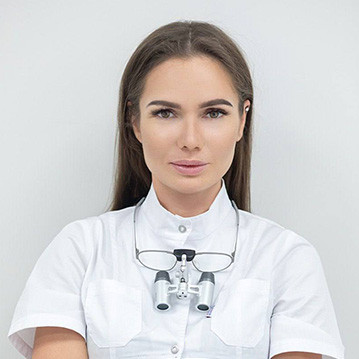Metal-ceramic crowns

specialists

equipment

treatment
General information about the procedure
Varieties

The procedure for manufacturing and installing metal-ceramic dental crowns requires precision and attention from both the dentist and and from the patient. At the first stage, the doctor conducts a thorough examination of the patient’s oral cavity and prescribes the necessary laboratory tests. An integrated approach allows you to accurately design the future crown.
After checking the condition of the oral cavity, the doctor begins to treat caries, fill the canals and professional cleaning. Then the tooth is prepared to create a support for the crown and a two-layer impression is taken. This stage is important for correctly determining the center of teeth closure and obtaining a high-quality imprint.
In the laboratory, an orthopedic structure is made based on the imprint. The process consists of the following steps:
- Turning out the frame. Manufacturing of the metal base of the crown.
- Frame fitting. Necessary for adjustment and correction of defects, without a porcelain layer.
- Choice of shade. Selecting the color of the porcelain so that the crown matches the color of your natural teeth.

How are metal-ceramic crowns installed? The installation process of metal ceramics also includes several stages.
- After treatment and preparation of the tooth for a prosthesis, the doctor takes an impression, which serves as the basis for creating a crown.
- The patient is temporarily fitted with protective braces while the laboratory produces the orthopedic structure.
- After making the frame, the doctor tries it on and clarifies the patient’s sensations. It is important to report any discomfort so that adjustments can be made.
- At the final stage, the final porcelain coating is carried out and the crown is installed in a permanent place.
The entire process of manufacturing and installing a metal-ceramic crown usually takes from 1.5 to 2 weeks and requires three visits to the dentist.
Classification and distinctive characteristics of metal-ceramic dentures

Depending on the frame material, metal-ceramic dental crowns come in the following types:
- Standard. Made of chrome with the addition of cobalt or nickel
- Titanium. They have increased strength, but are heavier
- Premium class. Made of gold or platinum, including palladium
Metal-ceramic crowns are also classified according to the porcelain processing method. Regular crowns undergo a standard firing process, which makes them smooth and durable. Low temperature crowns have a thinner coating to improve aesthetics, but are less dense than conventional crowns.
In case of damage, metal-ceramic crowns can be restored without removal. Because the nerves are removed, the teeth underneath are not susceptible to decay. In addition, crowns do not emit toxic substances even after prolonged use.
Advantages of installing metal-ceramic crowns in the K+31 dental clinic in Moscow
Advantages of metal-ceramics “turnkey” in the dental clinic “K+31” in Moscow:
- Qualification of specialists. The clinic’s doctors regularly participate in international conferences and undergo internships abroad, for example, in Germany and the USA, which allows them to apply the latest achievements in dentistry in practice
- Modern equipment and technologies. The clinic uses advanced technologies (digital planning, computed tomography), which ensure high accuracy when installing metal-ceramic crowns. This reduces the risk of complications and extends the service life of the crowns
- Cooperation with dental laboratories. The clinic cooperates with a leading German laboratory, which guarantees the use of safe and high-quality materials, precise correspondence of the crowns to the size and shape of the patient's teeth
- Innovative implantation methods. The use of the All-on-4, All-on-6 method allows you to install a full row of teeth on just four implants, which significantly reduces treatment time and reduces pain for patients.
- Comprehensive approach to treatment. Patients receive a full range of services in one place - from diagnostics to rehabilitation
Patients can find out about all the services and prices of metal ceramics not only in the clinic, but also by phone. To find out how much metal ceramics costs and make an appointment with a doctor, fill out the form on the website.

Answers to popular questions
Dentists from K+31 have addressed the main questions about turnkey metal-ceramic crowns.
How is a metal-ceramic crown installed on a preserved tooth root?
Installing a crown begins with filling the canals and restoring damaged areas of the tooth. Next, the doctor can either install a stump tab to fix the crown, or screw a pin into the remains of the tooth, grinding it down to securely fix the crown.
What solutions exist for installing a crown on an implant?
In case of complete tooth decay, implantation is used. An artificial root, most often made of titanium, is implanted into the jaw. This solution is suitable both for restoring chewing functions and for the aesthetics of the anterior group of teeth. The main disadvantage is the long wait for the implant to heal, which takes about five months.
What is a shoulder orthopedic design?
This is a type of crown with additional mass on the side of the frame. It hangs over the remains of the tooth, covering the darkening area that occurs due to the non-transmission of light by the metal frame.
What sensations may arise during the period of getting used to the new crown?
During the first weeks after crown installation, patients may experience the following symptoms:
- Light pressure on the gum
- Tightness in the area of incisors and premolars
- Diction problems, especially when restoring anterior teeth
- Discomfort when closing and chewing
- Slight increase in gum sensitivity
If severe pain occurs, you should immediately consult a doctor. This sign may indicate incorrect installation of the crown.
What kind of care is required for metal-ceramic crowns?
How long do metal-ceramic crowns last?
What restrictions apply after the crown is installed?

Modern methods of diagnostics and dental treatment at "K+31"
Our doctors

This award is given to clinics with the highest ratings according to user ratings, a large number of requests from this site, and in the absence of critical violations.

This award is given to clinics with the highest ratings according to user ratings. It means that the place is known, loved, and definitely worth visiting.

The ProDoctors portal collected 500 thousand reviews, compiled a rating of doctors based on them and awarded the best. We are proud that our doctors are among those awarded.
Make an appointment at a convenient time on the nearest date
Price
Other Services
Онлайн консультация стоматолога-ортопеда
Diagnosis and treatment of TMJ diseases Axiography of the TMJ Condylography of the TMJ MRI TMJ Splint therapy for TMJ Total dental rehabilitationOcclusion Analysis
Digital Smile Design (DSD) CEREC ceramic crowns, vineyards and deposits: 1 day manufacture and installation Boxing tire























































Design features
Metal-ceramic dental crowns consist of two key elements:
Metal-ceramic crowns are used not only as individual elements, but also as part of bridges and arches. They can be supported either by the patient’s own teeth or by implants, subject to compatibility. with the materials and abutments used.